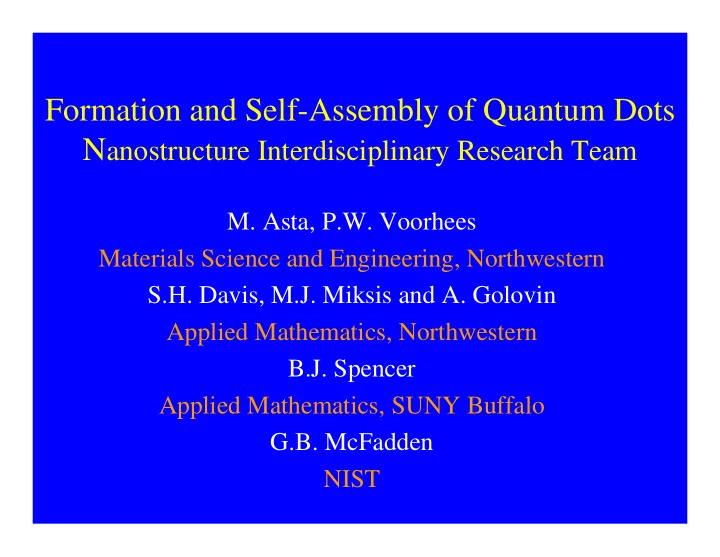

Formation and Self-Assembly of Quantum Dots N anostructure Interdisciplinary Research Team M. Asta, P.W. Voorhees Materials Science and Engineering, Northwestern S.H. Davis, M.J. Miksis and A. Golovin Applied Mathematics, Northwestern B.J. Spencer Applied Mathematics, SUNY Buffalo G.B. McFadden NIST
Interdisciplinary Research • Collaboration between materials scientists and applied mathematicians • Jointly supervised students and postdocs • Students will take courses in both departments • Postdocs will spend time at a NIST • Funded by both Div. Materials Research and Div. Mathematical Sciences at NSF • Research was initiated 2001
Projects Underway • First-principles calculation of surface stress and the stress-dependence of surface diffusion • Equilibrium shape of quantum dots on surfaces • Morphological stability of nanowires • Dynamics of surface evolution during deposition, both numerical and analytical • Stability of interfaces under stress with highly anisotropic surface energy
Thin Film Deposition • Deposit one material on another from the vapor
How do dots form? • Misfitting film is always unstable to the formation of ripples • Spencer and Meiron, Chiu and Gao, Yang and Srolovitz – Nonlinear evolution – Isotropic surface energy – Finite-time singularity (Spencer and Meiron (1994))
Quantum Dots in Ge-Si • Medeiros et al (1998) • Ge islands on Si substrate • Islands are faceted: pyramids and domes
Quantum Wires/Nanowires From Chen et al. STM topographs showing ErSi 2 From Chen et al. STM topographs showing ErSi 2 (011) nanowires grown on a flat Si(001) substrate. The (011) nanowires grown on a flat Si(001) substrate. The Si terraces increase in height from deep blue to green. Si terraces increase in height from deep blue to green.
Stability of Nanowires • Quantum wires with isotropic surface energy would tend to bead up rather than persist as wires. • Isotropic Case: Perturbation: H( φ ) sin (kz) Stable for λ < 2 π R • Anisotropic surface energy, but no missing orientations • No elastic stress (at the moment)
Rod Stability for Cubic Materials • n=0 cases are shown, n>1 are all stable • [001] Orientation: four-fold symmetry axis 1.5 1 Cross- Cross -sections of the sections of the 0.5 unperturbed rod for the [001] unperturbed rod for the [001] case: from the inner to the outer case: from the inner to the outer y 0 curve, ε ε 4 = - -0.0556, 0.0556, - -0.0278, 0, 0.0278, 0, curve, 4 = 0.0278, 0.0556, and 0.0833. 0.0278, 0.0556, and 0.0833. −0.5 −1 −1.5 −1.5 −1 −0.5 0 0.5 1 1.5 x
Rod Stability for Cubic Materials: [001] 2 3.5 ε 4 ε = - -0.0556 0.0556 4 = -0.0278 0.0278 - 3 1.5 0.0000 0.0000 0.0278 0.0278 2.5 0.0556 0.0556 1 0.0833 0.0833 2 σ κ c 2 0.5 1.5 0 1 −0.5 0.5 −1 0 0 0.5 1 1.5 2 −0.06 −0.04 −0.02 0 0.02 0.04 0.06 0.08 0.1 κ ε 4 • Eigenvalues • Eigenvalues for n =0 for n =0 The dotted curve The dotted curve • Isotropic: Isotropic: k k c = 1 • c = 1 represents an asymptotic represents an asymptotic • Anisotropy can stabilize or Anisotropy can stabilize or • solution. solution. destabilize the system destabilize the system • Rod always unstable Rod always unstable •
Rod Stability for Cubic Materials: [111] • [111] Orientation: three [111] Orientation: three- -fold symmetry axis fold symmetry axis • 5 4 3 2 k c 2 1 0 −0.1 −0.05 0 0.05 0.1 ε 4 The [111] orientation The [111] orientation has no plane of has no plane of symmetry normal to symmetry normal to cylinder axis cylinder axis
First Principles Calculations: Surface Stress and Surface Diffusion Si(001) c2x4 Dimer Reconstruction Top view: Bulk Atoms Surface Dimers [ 110 ] [ 1 1 0 ]
Ge Adatom Diffusion Calculations First-Principles Calculations Diffusion Path • Local Density Functional Theory – Plane-Wave Pseudopotential Calculations (VASP code) • NPACI Resources Adatom
Dynamics: Coarsening of Growing Anisotropic Surfaces Deposition flux Surface Diffusion Growth • Same regularization as used in the equilibrium shape work • No elastic stress
Dynamics: Convective Cahn-Hilliard • Long wave equation in one dimension: • D deposition rate, and u slope of the surface • D < D c • D > D c
Dynamics: Convective Cahn-Hilliard • Integrated long wave equation in two dimensions • • D < D 1 • D > D 1
Dynamics: Asymptotics • Convective Cahn-Hilliard equation, same anisotropic surface energy • Asymptotic solutions in the limit of small corner curvature • Evolution of surface given in terms of the motion of kinks and antikinks V
Projects Underway • First-principles calculation of surface stress and the stress-dependence of surface diffusion • Equilibrium shape of quantum dots on surfaces • Morphological stability of nanowires • Dynamics of surface evolution during deposition, both numerical and analytical • Stability of interfaces under stress with highly anisotropic surface energy
Recommend
More recommend